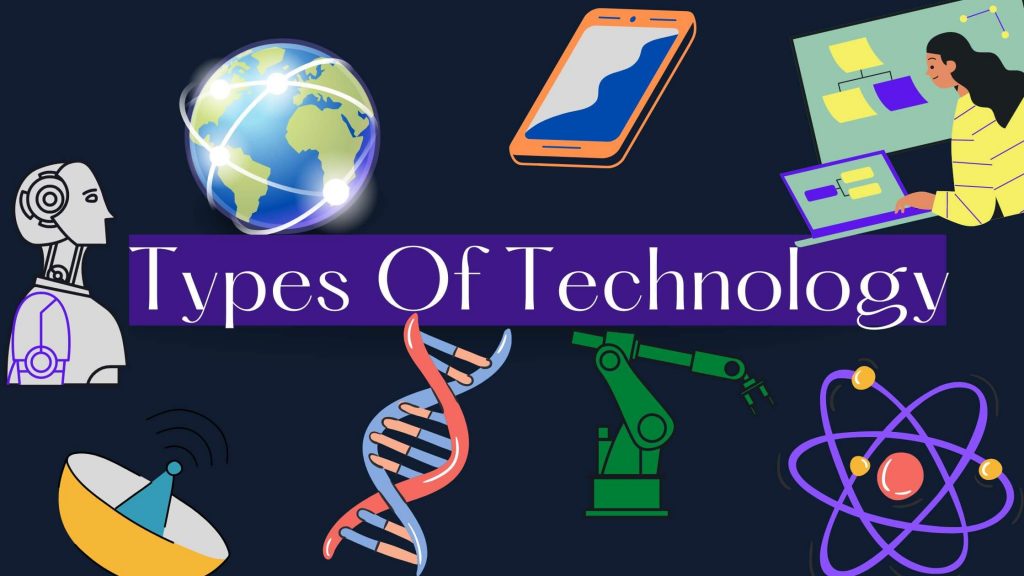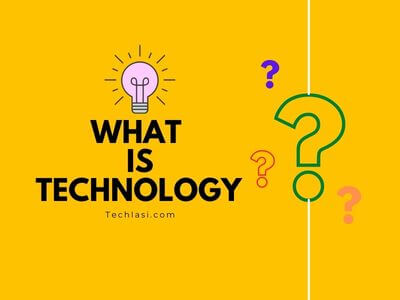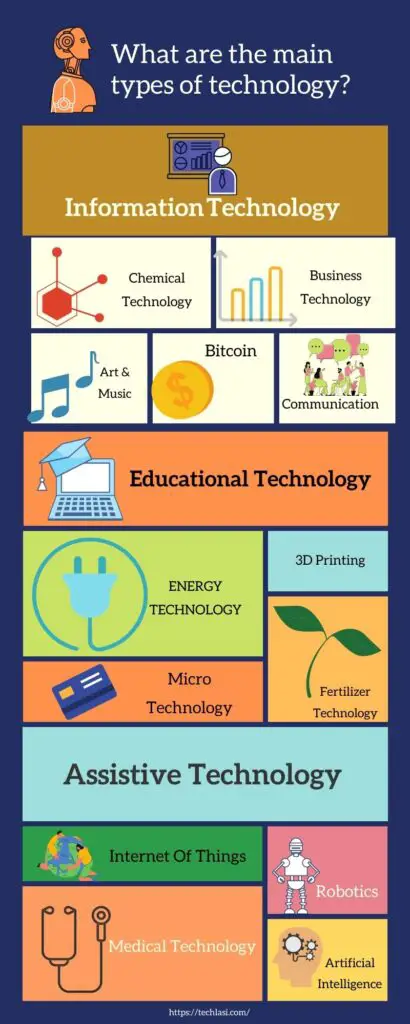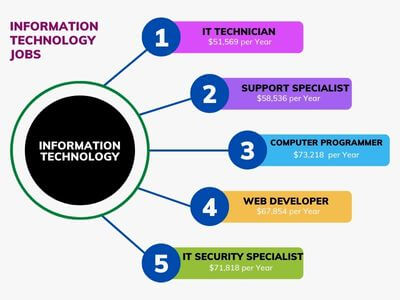
There are lot of types of technology in every field of life. Technology is everywhere, and progress is proceeding. Suppose you are reading this article on your computer/mobiles. Yes, your computer/mobile is running on electric power and you have Windows installed on your computer which is an operating system. Moreover, you are using the internet, it is also a technology.
In this modern era, technology has conquered the mind of humans by creating a lot of easiness for it. If we look around us, we can see that in every matter of life, whether it is hard or easy to deal with, we have to solve it with the help of technology. No doubt, with the miracles of emerging technology, the world has become more charming and attractive, but keep in mind everything has its demerits that depend upon its use.
Let’s move toward the question of the day: How many different types of technology? What are their benefits in our life? Before moving toward the main question, it is necessary to know about the brief introduction of technology and how it has revolutionized the life of people. Let’s move ahead.
How many total types of technology
So far, you have come to understand that different types of technology surround you. According to Wikipedia information, there are about 67 types which are serving to improve the daily life in 2025. We are referring to some of these most known and in-demand technologies.
What is Technology?

There are many definitions of technology. but in simple terms, the uses and implementation of scientific theories in practical life through a device or machine is technology.
The definition of technology is subjective and varies from person to person. Here, we are with the most applicable definition covering technology’s whole meaning. Technology is the use of tools for the convenience of mankind. Every invented thing that has created ease for humanity comes within the scope of technology.
We can say that the things that have brought human life to a pro-level by making it easy are called technology.
Technology Advancements and Types: Insights from Leading Institutions
| Institution | Technology Advancements | Technology Types |
|---|---|---|
| Massachusetts Institute of Technology (MIT) | AI and Machine Learning | Artificial Intelligence |
| Stanford University | Quantum Computing | Quantum Computing |
| California Institute of Technology (Caltech) | Space Exploration | Aerospace, Satellite Technology |
| Carnegie Mellon University | Human-Computer Interaction | Human-Computer Interaction, User Experience |
| Harvard University | Nanotechnology | Nanotechnology |
| University of Cambridge | Renewable Energy | Sustainable Energy Sources |
| University of California, Berkeley | Data Science | Data Analytics, AI, Machine Learning |
| National Aeronautics and Space Administration (NASA) | Aerospace Technology | Aerospace, Space Exploration |
| CERN (European Organization for Nuclear Research) | Particle Physics | High-Energy Physics, Computing |
| IBM Research | Quantum Computing | Quantum Computing |
10 Benefits of Technology
- More productivity and efficiency
- Better ways to talk to each other and work together.
- Access to a lot of information.
- More convenience and comfort.
- Better medicine and health care
- Better chances to get an education
- Safety and security have gotten better
- Entertainment has gotten better.
- More job opportunities
- Raised the overall quality of life.
To get a clear idea of this topic, first of all, we will have to discuss the types of technology that are proving their worth in different fields of life. Let’s discuss them in detail.
What are the main types of technology?

1. Haptic Technology
Haptic Technology is the most emerging type of technology that deals with transmitting and understanding information through touch. Simply put, we can say the form of technology that can produce an experience of touch by applying vibrations, forces or motions to the user is called haptic technology. It is also known as kinaesthetic communication or 3D touch. It facilitates nonverbal communication in which people can communicate by creating a sense of touch.
Applications:
| Application | Haptic Technology |
|---|---|
| Virtual Reality (VR) | Enhances user experience by providing tactile feedback and realistic touch sensations in virtual environments. |
| Medical Simulations | Enables medical professionals to practice procedures and treatments on virtual patients with realistic haptic feedback. |
What is haptic technology in digital media
In digital media, haptic technology is the use of touch and tactile feedback to simulate the physical sensations of touch, pressure, temperature, and vibrations. With this technology, people can feel and touch virtual objects, just like they can in the real world. This makes it easier and more fun to use digital devices. Haptic technology is often used in smartphones, game controllers, and virtual reality (VR) and augmented reality (AR) systems to make the user experience more realistic and interesting.
2. Quantum Technology
Quantum technology is based on principles of quantum mechanics. Quantum mechanics is the branch of physics that deals with subatomic particles such as protons, neutrons, and electrons. The first miracle of quantum technology was the invention of transistors, which laid the foundation of intelligent computer and digital communication.
It is the technology of nanosize that is a million times faster and more powerful than the most advanced technology of today. People can use it to solve complicated equations within a few moments, which may take thousands of years in a traditional computer.
Moreover, it can also help us understand our past and the universe’s origins. It’s incredible to know that it is also helpful to pursue a better and advanced future beyond our imaginations.
Applications:
| Application | Quantum Technology |
|---|---|
| Quantum Computing | Enables solving complex problems exponentially faster using quantum bits (qubits). |
| Quantum Communication | Enables secure communication using quantum key distribution and quantum entanglement. |
| Quantum Sensing | Allows highly sensitive measurements for navigation, imaging, and medical applications. |
| Quantum Cryptography | Provides unbreakable encryption using quantum key distribution and quantum entanglement. |
How to invest in quantum technology?
There are several ways to put money into quantum technology:
Investing in companies that work with quantum technology: This includes companies that make and sell hardware, software, and consulting services that use quantum technology.
Putting money into quantum technologies ETFs, or Exchange Traded Funds, are investment funds that track the performance of a specific market segment, like the quantum technology sector.
Putting money into venture capital firms: Some venture capital firms focus on investing in startups in the early stages of quantum technology.
Putting money directly into research on quantum technology. This includes putting money into quantum technology research and development at universities.
3. Architecture Technology
The form of technology used to design buildings is called architectural technology. This technology is used to improve the building’s durability, beauty and efficiency. Using it, architects can make virtual 3D models of buildings to ensure client’s needs before starting actual work.
It also monitors all the aspects of constructing projects, such as risks and required modifications. Architectural technology is widely used in the construction industry.
Applications:
| Application | Architecture Technology |
|---|---|
| Building Information Modeling (BIM) | Allows architects and engineers to create and manage digital representations of building projects, improving collaboration and efficiency in the design process. |
| Parametric Design | Enables architects to create complex and customizable designs using algorithms and mathematical parameters, leading to innovative and sustainable structures. |
| Augmented Reality (AR) Visualization | Allows architects and clients to visualize and experience building designs in real-world settings, enhancing the understanding of spatial concepts and design decisions. |
How does technology affect architecture?
In many ways, technology has made a big difference in architecture:
Design and visualization: Technology has made it possible for architects to make very accurate and detailed 3D models and virtual tours of their designs. This makes it easier for them to present their ideas to clients and other stakeholders and get them to understand their vision.
Construction processes: Technology has changed the construction industry in a big way, making building faster and more accurate.
For example, building information modelling (BIM) software has made it easier to manage and coordinate projects, so mistakes and delays are less likely to happen.
Sustainability: Technology has made it possible for architects to create buildings that use less energy by using smart heating, ventilation, and cooling systems.
Material innovations: Changes in how materials are made have given architects new ways to design buildings. For example, the use of lighter and stronger materials like carbon fibre and advanced composites has allowed architects to build more ambitious and daring structures.
Building Automation: By putting technology into building systems, “smart buildings” have been made that can save energy, control lighting and heating, and check on occupancy and safety.
Overall, technology has had a big impact on architecture. It has helped architects push the limits of design, make buildings that are better for the environment, and speed up the building process.
4. Biotechnology
As it is shown in its name, biotechnology which means it deals with living organisms. Biotechnology is the study of the use of microorganisms (bacteria, yeast, and algae) to form useful products such as yogurt, vinegar, and many other medicines. Simply, we can say that the use of microorganisms for the welfare of humanity is called biotechnology.
Applications:
| Application | Biotechnology |
|---|---|
| Genetic Engineering | Manipulates DNA to modify and introduce new traits in organisms for medical, agricultural, and industrial purposes. |
| Biopharmaceuticals | Produces drugs and vaccines using biological systems, such as bacteria and yeast, to treat various diseases and medical conditions. |
| Environmental Biotechnology | Applies biotechnological processes to address environmental issues, such as wastewater treatment, bioremediation, and sustainable energy production. |
| Synthetic Biology | Designs and constructs artificial biological systems for novel applications, ranging from creating biofuels to developing biosensors. |
What is industrial biotechnology
Industrial biotechnology is a type of biotechnology that uses the ideas of biological science to create new ways to do things in industry.
The goal of industrial biotechnology is to use biological systems instead of chemical processes to make chemicals, materials, and energy.
Some examples of how biotechnology is used in industry are:
Biofuels are fuels made from plant-based materials, like ethanol and biodiesel.
Bioplastics are made from renewable resources like corn starch, sugar cane, and cassava to make plastics that break down over time.
Biochemical production is when microorganisms or enzymes are used to make chemicals like amino acids, organic acids, and solvents.
Bioremediation is when microorganisms are used to clean up dirty sites and reduce pollution in the environment.
Biopharmaceuticals are drugs and other medical products that are made from living organisms or their parts.
Industrial biotechnology has many advantages over traditional chemical processes, such as less reliance on fossil fuels, less damage to the environment, and more efficient use of energy. It is a field that is growing quickly and has many exciting new developments and research and business opportunities.
5. Information Technology

Who is not familiar with Information technology? This technology is computer and internet-based. More than half of the world’s business affairs are being handled through information technology and it’s resources. IT is the use of Computer hardware, software and network for safe storage of data and easy access to information.
Applications:
| Application | Information Technology |
|---|---|
| Cloud Computing | Delivers on-demand computing resources, including storage, servers, and applications, over the internet. |
| Cybersecurity | Protects computer systems, networks, and data from unauthorized access, attacks, and breaches. |
| Big Data Analytics | Extracts insights and patterns from large volumes of data, enabling data-driven decision-making and business intelligence. |
Is information technology hard?
Information technology can be easy or hard, depending on what part of the field you want to learn about and how much you already know and have done. Some things, like programming or network administration, can be hard to learn and require a lot of technical knowledge and time, while others, like basic computer use or digital literacy, may be easier.
Overall, it’s a tough field that requires constant learning and adapting to new technologies and trends, but with the right tools and drive, it can also be very rewarding.
What is a common axiom for information technology professionals?
“Garbage in, garbage out” is a common saying among people who work in information technology (GIGO). This means that the quality of a system or process’s output is directly related to the quality of its input.
In other words, if the data or information that goes into a system isn’t very good, the results that system gives out will also not be very good.
The GIGO axiom reminds IT professionals to pay attention to how accurate and reliable the data they are working with is, as well as how accurate and reliable the systems and processes are that they use to manage and analyse that data. It is a way to make sure that the information technology results are useful and meaningful.
6. Communication (one of the the most useful types of technology)
Who does not know the value of communication nowadays? Whether it’s exchanging ideas or business conversations by Video Conferencing System, expressing your feelings or downloading some information from the internet, communication is a must. In addition, Telecommunication technology helps provide proper contact arrangements in less time. Thus, It would be right to state that Modern communication technology has laid the foundation for our new world.
Applications:
| Application | Communication Technology |
|---|---|
| Wireless Communication | Enables data transmission without physical connections, used in smartphones, Wi-Fi, and Bluetooth devices. |
| Fiber Optics | Uses optical fibers to transmit data as light signals, providing high-speed and long-distance communication in internet and telecommunications networks. |
What is a common axiom for information technology professionals
Several technologies have made instant and more effective communication around the world possible, such as:
Internet: Because the Internet is so popular, people from anywhere in the world can talk to each other and share information in real time.
Email: Electronic mail, or email, has changed the way people talk to each other by letting them send and receive messages right away, no matter where they are.
Instant Messaging (IM): Apps like WhatsApp, WeChat, and Facebook Messenger let people send each other text messages, pictures, and videos in real time.
Video conferencing: Technologies like Zoom, Skype, and Google Meet have made it possible to hold virtual meetings, interviews, and presentations with people from all over the world.
Social Media: Social media platforms like Twitter, Facebook, and LinkedIn have opened up new ways for millions of people around the world to communicate and share information.
Mobile Devices: People can stay in touch and talk to each other from anywhere, at any time, thanks to the widespread use of smartphones and other mobile devices.
These technologies have changed the way we talk to each other and made it much easier for people all over the world to connect and work together.
7. Energy Technology
The energy sector is doubtlessly one of the most critical areas in the world that can lead to war. Why the energy shortage in the world is rapidly increasing from time to time, conversely the production of energy in all countries is decreasing.
Consequently, If anything helps us in this situation, that is energy technology. Furthermore, With the help of this technology, our scientists are always trying to find alternative resources of energy.
Applications:
| Application | Energy Technology |
|---|---|
| Solar Power | Converts sunlight into electricity using photovoltaic cells, providing renewable and sustainable energy. |
| Wind Power | Generates electricity from wind turbines, harnessing wind energy as a clean and eco-friendly power source. |
| Hydropower | Utilizes flowing or falling water to produce electricity, an eco-friendly energy option for various scales of power generation. |
Which energy technology is more sustainable long term?
Most people think that the following energy technologies can be used for a long time:
Wind, sun, water, and geothermal power are all types of renewable energy. Smart grid systems, energy-efficient buildings, and energy-efficient appliances are all examples of ways to save energy.
When done right, nuclear energy can also be a long-term, sustainable energy source.
8. Space Technology
The type of technology which is used to elaborate space is known as space technology. Space tech is very helpful to discover the hidden secrets of our Universe. Space technology is also used for spacecrafts and satellites.
Going into space, exploring and discovering there has always been a human desire. In modern times science has proven this desire possible with the help of this technology. Furthermore; Space technology is also useful for astronomy and to know the weather conditions in near future.
Space Technology Applications:
| Application | Space Technology |
|---|---|
| Satellite Communication | Facilitates long-distance communication, broadcasting, and internet services through satellites in space. |
| Earth Observation | Uses satellites to monitor and collect data on Earth’s atmosphere, land, oceans, and climate for environmental and scientific research. |
| Space Exploration | Enables missions to explore celestial bodies, study cosmic phenomena, and search for signs of life beyond Earth. |
How can spectroscopy and infrared technology be useful in space?
There are a lot of ways that spectroscopy and infrared technology can be used in space. Here are just a few:
Remote sensing: Spectroscopy can be used to study the composition and physical properties of celestial objects and atmospheres from afar, which can tell us important things about how they are built and how they change over time.
Planetary exploration: Infrared technology can be used to map the surface of planets and study their atmospheres. This helps find out if there is water and other volatile compounds that are needed for life.
Astronomical observations: Spectroscopy can be used to learn about the makeup and physical properties of stars and galaxies. This helps us understand how they formed and changed over time.
Monitoring the environment: Infrared technology can be used to keep an eye on the temperature and amount of radiation in space, which helps keep astronauts and satellites safe.
9. Artificial Intelligence
Although, Machines are either controlled by remote or any other controlling device conversely Creating so much potential in the machine that they can work without fault is called Artificial Intelligence. In other words, thinking and judging of a device in a very human way is Artificial Intelligence. For example, gpt-3 technology.

With the help of artificial intelligence, many devices and robots are produced that can think and perceive like human senses. It has replaced humans with robots and machines in many working areas.
Today is the era of AI, where human intervention is not necessary to perform every task. Nowadays, it is working in these areas such as speech recognition, problem-solving, learning and planning, transportation, finance, healthcare, and banking. In addition, it has become a threat to human laborers.
AI Applications:
| Application | Artificial Intelligence |
|---|---|
| Natural Language Processing (NLP) | Enables machines to understand, interpret, and respond to human language, used in virtual assistants and language translation. |
| Machine Learning | Empowers systems to learn and improve from experience, used in personalized recommendations, fraud detection, and image recognition. |
Should artificial intelligence be capitalized?
Whether or not “artificial intelligence” needs a capital letter depends on the style guide being used. Most of the time, when a word is used as a proper noun to talk about a specific field of study or technology, it is best to write it with a capital letter.
For example: “Artificial Intelligence is a field of technology that is growing quickly.”
Some style guides, though, say not to capitalise it when it’s used as a common noun or a general description. For example, “Artificial intelligence is used to improve efficiency in many industries.”
10. Robotics
Basically, Robotics is a branch of science in which many branches are accumulating includes Mechanical engineering, electronic engineering, information engineering, computer science and Artificial Intelligence.
Although the basic idea of robotics is to create a machine that can do human alternatives. However; just one technology is not enough to achieve this goal.
Robotics Applications:
| Application | Robotics |
|---|---|
| Industrial Automation | Automates manufacturing tasks like welding, assembly, and material handling in industries. |
| Autonomous Vehicles | Enables self-driving vehicles and drones to operate without human intervention. |
How recent advancements in robot technology impacts the world?
Recent improvements in robot technology have made a big difference in many fields. For example, they have helped make manufacturing, healthcare, and transportation more productive, efficient, and accurate.
Also, robots are being made for use in fields like education, entertainment, and care for the elderly. This opens up new ways to grow and improve. But there are also worries about robots taking over jobs and ethical questions about how robots should be used.
Overall, the effects of robotics technology are complicated and wide-ranging, and they will keep changing as the technology improves.
11. Internet Of Things (IOT)
Internet of Things is especially a system that connects many systems and allows them to automate data transfer without any human assistance.
Additionally, this technology includes computers, mechanical machines, digital machines and even accessories. Although, smart home, smart AC and modern refrigerators are all examples of IoT.
12. Environment Technology
Specifically, This technical term is used to try to keep the environment clean. But, Green Tech and Clean Tech are its two other names. Basically, Its primary objective is to provide an environment-friendly atmosphere, furthermore; It also receives support from other technologies for this purpose.
13. Hydraulics Technology
Hydraulics technology or fluid technology is a combination of chemistry, mechanics and the use of fluids in machines. In other words, the use of hydraulics in mechanics is called fluid technology. It is considered an alternative to pneumatics.
14. Medical Technology
Although, medical technology is the technology in which medicine, new devices, new research and new methods are used for investigating, and solving the health problems. Medical technology also includes the use of computers while caring for patients in the USA is also considered a part of medical technology.
15. Micro Technology
Micro-technology is a technology that reduces the size of a device by making a new structure over a millimetre area. Scientists are using Such micromesh devices in automatic airbags and medical devices; simultaneously, this technology is expected to be widely used shortly.
16. Forensic Technology
Forensic Technology refers to using tech-related tools to investigate and analyze crimes. It is the combination of law and computer science elements that are used to analyze the data stored in multiple devices such as computer systems, networks, and wireless communications for investigation.
Using forensic technology, people can go in-depth about any incident by analyzing the facts and figures stored on digital devices. It has brought a 360° revolution in the legal investigation process by making it too easy.
Nowadays, The personnel of investigation agencies use forensic technology widely to investigate complicated crimes. With the help of Forensic Technology , they collect, analyze, and interpret the information to get an effective outcome.
Moreover, it has made the investigation process easier and faster than in the past.
17. Nanotechnology (Emerging type of technology)
Nanotechnology is used to observe and study the objects of a nanometer. Considering that there are billions of nanoparticles in one meter. Basically, nanotechnology is the study of tiny things. Thus we may also say that this is a technology to test and control atoms or molecules.
18. Waste treatment Technologies
Waste Treatment technologies have many ways to discard, recycle and convert waste into energy. Due to this innovative technology, we can have a cleaner environment and may even meet energy shortage
19. Fertilizer Technology
Fertilizer technology was introduced first time in 1950 in United States. It covers the areas of fertilization. Scientists are doing research in this field to get remarkable success. An investment of $57 billion is in fertilization research field till 2025 according to our research.
20. 3D Printing Technology
This type of technology is used to create three dimensional solid objects. Additive manufacturing is also called 3D Printing.
21. Assistive Technology
This type of technology proved very helpful for disable persons. Assistive technology helps them in daily activities. Due to it, the lifestyle of disable people is improved. It can decrease the effects of disability. With this type of tech disable person can perform many daily life activities without any hassle.
22. Art & Music (one of the most common types of technology)
Technology is used to compose different new musical instruments. Due to technology the quality of Music is increased. Technology is also useful in composing new symphonies. We create 3D music, Dj songs, and also we edit and compose new songs in Art and Music Technology.
23. Educational Technology

In past, the methods of education were different. But now, we are living in a modern world. The methods and sources of education are now changed. The use of technology in educational field has improved it’s quality and benefits. Technology is helping students to do better research. It has also helped students to gain knowledge easily in far off areas.
24. Chemical Technology ( High paying type of technology)
Chemical technology is used for research purpose. In the field, chemist do experiments on different things to do research on hidden secrets of life. Chemical technology is worthy for all the other types of technology because chemicals are the essential part of all most everything.
25. Business Technology
Business Technology is a combined type of technology. It involves many types of technology. Business Technology was introduced first time in 1989. Business technology has helped a lot to grow small businesses.
26. Construction Technology
Construction technology refers to the collection of all the innovative tools, machinery, software and techniques that have created a lot of ease in completing construction projects. With the help of construction technology, the months’ work can be done within days. It has also proved the right choice to increase buildings’ reliability, durability, and beauty.
Using construction technology, the most challenging construction tasks, such as the construction of bridges and complex buildings, have become the work of the right hand.Using construction technology, the most challenging construction tasks, such as the construction of bridges and complex buildings, have become the work of the right hand.
27. Smoke Detection Technology
The term “smoke detection technology” refers to the different tools and systems that are used to find and warn about smoke. The main goal of smoke detection technology is to let people know about a fire as soon as possible so they have time to get out and avoid getting hurt or damaging property.
There are many different kinds of smoke detectors, such as ionisation smoke detectors, photoelectric smoke detectors, dual-sensor smoke detectors, and optical smoke detectors.
These smoke detectors can be powered by batteries or hooked up to a building’s electrical system. They can be used in homes, businesses, and factories.
What are the two types of smoke detection technologies
There are two main kinds of smoke detectors: those that use ionisation and those that use photoelectricity.
Ionization A small amount of radioactive material is used to ionise the air in the smoke detector’s detection chamber. This makes a current flow between two electrodes. When smoke gets into the chamber, it stops the ions from moving, which lowers the current and sets off the alarm.
On the other hand, photoelectric smoke detectors use a light source and a photocell to pick up on smoke. The light beam goes all the way across the chamber. When smoke gets into the chamber, it scatters the light, which the photocell can see. This makes the alarm go off.
Different kinds of technology list
| Different Technology Types |
|---|
| Robotics |
| Art & Music |
| Biotechnology |
| Communication |
| Nanotechnology |
| Microtechnology |
| Space Technology |
| Haptic Technology |
| Energy Technology |
| Medical Technology |
| Artificial Intelligence |
| Forensic Technology |
| Assistive Technology |
| Business Technology |
| Fertilizer Technology |
| Quantum Technology |
| Chemical Technology |
| Hydraulics Technology |
| Educational Technology |
| 3D Printing Technology |
| Architecture Technology |
| Information Technology |
| Environment Technology |
| Construction Technology |
| Waste Treatment Technologies |
FAQ’s
How has technology revolutionized human life?
Technology has brought a revolution in our lives by making them easy. Now, We can do tough and time-consuming tasks in a few minutes with the help of technology. Now, distance has become short to cover, problems have become easy to solve, and things have become more innovative than in the past due to technology.
Which is the most emerging type of technology?
Artificial intelligence is the most emerging type of technology at present. Millions of research articles by thousands of authors have been published on this topic. Moreover, it is the only form of technology replacing humans by thinking and working like them.
What is the scope of Nanotechnology?
Nanotechnology deals with nanoparticles that are invisible to the naked eye. Its scope is vast due to its day-by-day emerging applications. It is widely used in tech-related gadgets, machinery and robots.
Conclusion
In conclusion, The right use of any technology can create great success in human life. But conversely, misuse of technology can pose a massive threat to human life. Accordingly, Time determines the profit and loss of everything. A well-researched and detailed overview about the most important types of technology by TechLasi.
Read more about Future Technology
- What is One Challenge in Ensuring Fairness in Generative AI: The Hidden Bias Problem - August 15, 2025
- How Small Language Models Are the Future of Agentic AI - August 15, 2025
- What Are the Four Core Characteristics of an AI Agent? - August 15, 2025
